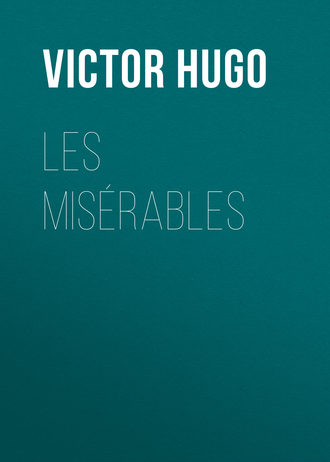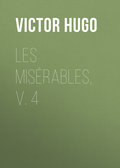
Виктор Мари Гюго
Les Misérables
CHAPTER V – PRESENT PROGRESS
To-day the sewer is clean, cold, straight, correct. It almost realizes the ideal of what is understood in England by the word “respectable.” It is proper and grayish; laid out by rule and line; one might almost say as though it came out of a bandbox. It resembles a tradesman who has become a councillor of state. One can almost see distinctly there. The mire there comports itself with decency. At first, one might readily mistake it for one of those subterranean corridors, which were so common in former days, and so useful in flights of monarchs and princes, in those good old times, “when the people loved their kings.” The present sewer is a beautiful sewer; the pure style reigns there; the classical rectilinear alexandrine which, driven out of poetry, appears to have taken refuge in architecture, seems mingled with all the stones of that long, dark and whitish vault; each outlet is an arcade; the Rue de Rivoli serves as pattern even in the sewer. However, if the geometrical line is in place anywhere, it is certainly in the drainage trench of a great city. There, everything should be subordinated to the shortest road. The sewer has, nowadays, assumed a certain official aspect. The very police reports, of which it sometimes forms the subject, no longer are wanting in respect towards it. The words which characterize it in administrative language are sonorous and dignified. What used to be called a gut is now called a gallery; what used to be called a hole is now called a surveying orifice. Villon would no longer meet with his ancient temporary provisional lodging. This network of cellars has its immemorial population of prowlers, rodents, swarming in greater numbers than ever; from time to time, an aged and veteran rat risks his head at the window of the sewer and surveys the Parisians; but even these vermin grow tame, so satisfied are they with their subterranean palace. The cesspool no longer retains anything of its primitive ferocity. The rain, which in former days soiled the sewer, now washes it. Nevertheless, do not trust yourself too much to it. Miasmas still inhabit it. It is more hypocritical than irreproachable. The prefecture of police and the commission of health have done their best. But, in spite of all the processes of disinfection, it exhales, a vague, suspicious odor like Tartuffe after confession.
Let us confess, that, taking it all in all, this sweeping is a homage which the sewer pays to civilization, and as, from this point of view, Tartuffe’s conscience is a progress over the Augean stables, it is certain that the sewers of Paris have been improved.
It is more than progress; it is transmutation. Between the ancient and the present sewer there is a revolution. What has effected this revolution?
The man whom all the world forgets, and whom we have mentioned, Bruneseau.
CHAPTER VI – FUTURE PROGRESS
The excavation of the sewer of Paris has been no slight task. The last ten centuries have toiled at it without being able to bring it to a termination, any more than they have been able to finish Paris. The sewer, in fact, receives all the counter-shocks of the growth of Paris. Within the bosom of the earth, it is a sort of mysterious polyp with a thousand antennæ, which expands below as the city expands above. Every time that the city cuts a street, the sewer stretches out an arm. The old monarchy had constructed only twenty-three thousand three hundred metres of sewers; that was where Paris stood in this respect on the first of January, 1806. Beginning with this epoch, of which we shall shortly speak, the work was usefully and energetically resumed and prosecuted; Napoleon built – the figures are curious – four thousand eight hundred and four metres; Louis XVIII., five thousand seven hundred and nine; Charles X., ten thousand eight hundred and thirty-six; Louis-Philippe, eighty-nine thousand and twenty; the Republic of 1848, twenty-three thousand three hundred and eighty-one; the present government, seventy thousand five hundred; in all, at the present time, two hundred and twenty-six thousand six hundred and ten metres; sixty leagues of sewers; the enormous entrails of Paris. An obscure ramification ever at work; a construction which is immense and ignored.
As the reader sees, the subterranean labyrinth of Paris is to-day more than ten times what it was at the beginning of the century. It is difficult to form any idea of all the perseverance and the efforts which have been required to bring this cesspool to the point of relative perfection in which it now is. It was with great difficulty that the ancient monarchical provostship and, during the last ten years of the eighteenth century, the revolutionary mayoralty, had succeeded in perforating the five leagues of sewer which existed previous to 1806. All sorts of obstacles hindered this operation, some peculiar to the soil, others inherent in the very prejudices of the laborious population of Paris. Paris is built upon a soil which is singularly rebellious to the pick, the hoe, the bore, and to human manipulation. There is nothing more difficult to pierce and to penetrate than the geological formation upon which is superposed the marvellous historical formation called Paris; as soon as work in any form whatsoever is begun and adventures upon this stretch of alluvium, subterranean resistances abound. There are liquid clays, springs, hard rocks, and those soft and deep quagmires which special science calls moutardes.59 The pick advances laboriously through the calcareous layers alternating with very slender threads of clay, and schistose beds in plates incrusted with oyster-shells, the contemporaries of the pre-Adamite oceans. Sometimes a rivulet suddenly bursts through a vault that has been begun, and inundates the laborers; or a layer of marl is laid bare, and rolls down with the fury of a cataract, breaking the stoutest supporting beams like glass. Quite recently, at Villette, when it became necessary to pass the collecting sewer under the Saint-Martin canal without interrupting navigation or emptying the canal, a fissure appeared in the basin of the canal, water suddenly became abundant in the subterranean tunnel, which was beyond the power of the pumping engines; it was necessary to send a diver to explore the fissure which had been made in the narrow entrance of the grand basin, and it was not without great difficulty that it was stopped up. Elsewhere near the Seine, and even at a considerable distance from the river, as for instance, at Belleville, Grand-Rue and Lumière Passage, quicksands are encountered in which one sticks fast, and in which a man sinks visibly. Add suffocation by miasmas, burial by slides, and sudden crumbling of the earth. Add the typhus, with which the workmen become slowly impregnated. In our own day, after having excavated the gallery of Clichy, with a banquette to receive the principal water-conduit of Ourcq, a piece of work which was executed in a trench ten metres deep; after having, in the midst of land-slides, and with the aid of excavations often putrid, and of shoring up, vaulted the Bièvre from the Boulevard de l’Hôpital, as far as the Seine; after having, in order to deliver Paris from the floods of Montmartre and in order to provide an outlet for that river-like pool nine hectares in extent, which crouched near the Barrière des Martyrs, after having, let us state, constructed the line of sewers from the Barrière Blanche to the road of Aubervilliers, in four months, working day and night, at a depth of eleven metres; after having – a thing heretofore unseen – made a subterranean sewer in the Rue Barre-du-Bec, without a trench, six metres below the surface, the superintendent, Monnot, died. After having vaulted three thousand metres of sewer in all quarters of the city, from the Rue Traversière-Saint-Antoine to the Rue de l’Ourcine, after having freed the Carrefour Censier-Mouffetard from inundations of rain by means of the branch of the Arbalète, after having built the Saint-Georges sewer, on rock and concrete in the fluid sands, after having directed the formidable lowering of the flooring of the vault timber in the Notre-Dame-de-Nazareth branch, Duleau the engineer died. There are no bulletins for such acts of bravery as these, which are more useful, nevertheless, than the brutal slaughter of the field of battle.
The sewers of Paris in 1832 were far from being what they are to-day. Bruneseau had given the impulse, but the cholera was required to bring about the vast reconstruction which took place later on. It is surprising to say, for example, that in 1821, a part of the belt sewer, called the Grand Canal, as in Venice, still stood stagnating uncovered to the sky, in the Rue des Gourdes. It was only in 1821 that the city of Paris found in its pocket the two hundred and sixty-thousand eighty francs and six centimes required for covering this mass of filth. The three absorbing wells, of the Combat, the Cunette, and Saint-Mandé, with their discharging mouths, their apparatus, their cesspools, and their depuratory branches, only date from 1836. The intestinal sewer of Paris has been made over anew, and, as we have said, it has been extended more than tenfold within the last quarter of a century.
Thirty years ago, at the epoch of the insurrection of the 5th and 6th of June, it was still, in many localities, nearly the same ancient sewer. A very great number of streets which are now convex were then sunken causeways. At the end of a slope, where the tributaries of a street or crossroads ended, there were often to be seen large, square gratings with heavy bars, whose iron, polished by the footsteps of the throng, gleamed dangerous and slippery for vehicles, and caused horses to fall. The official language of the Roads and Bridges gave to these gratings the expressive name of Cassis.60
In 1832, in a number of streets, in the Rue de l‘Étoile, the Rue Saint-Louis, the Rue du Temple, the Rue Vieille-du-Temple, the Rue Notre-Dame de Nazareth, the Rue Folie-Méricourt, the Quai aux Fleurs, the Rue du Petit-Musc, the Rue du Normandie, the Rue Pont-Aux-Biches, the Rue des Marais, the Faubourg Saint-Martin, the Rue Notre Dame des-Victoires, the Faubourg Montmartre, the Rue Grange-Batelière, in the Champs-Élysées, the Rue Jacob, the Rue de Tournon, the ancient gothic sewer still cynically displayed its maw. It consisted of enormous voids of stone catch-basins sometimes surrounded by stone posts, with monumental effrontery.
Paris in 1806 still had nearly the same sewers numerically as stated in 1663; five thousand three hundred fathoms. After Bruneseau, on the 1st of January, 1832, it had forty thousand three hundred metres. Between 1806 and 1831, there had been built, on an average, seven hundred and fifty metres annually, afterwards eight and even ten thousand metres of galleries were constructed every year, in masonry, of small stones, with hydraulic mortar which hardens under water, on a cement foundation. At two hundred francs the metre, the sixty leagues of Paris’ sewers of the present day represent forty-eight millions.
In addition to the economic progress which we have indicated at the beginning, grave problems of public hygiene are connected with that immense question: the sewers of Paris.
Paris is the centre of two sheets, a sheet of water and a sheet of air. The sheet of water, lying at a tolerably great depth underground, but already sounded by two bores, is furnished by the layer of green clay situated between the chalk and the Jurassic lime-stone; this layer may be represented by a disk five and twenty leagues in circumference; a multitude of rivers and brooks ooze there; one drinks the Seine, the Marne, the Yonne, the Oise, the Aisne, the Cher, the Vienne and the Loire in a glass of water from the well of Grenelle. The sheet of water is healthy, it comes from heaven in the first place and next from the earth; the sheet of air is unhealthy, it comes from the sewer. All the miasms of the cesspool are mingled with the breath of the city; hence this bad breath. The air taken from above a dung-heap, as has been scientifically proved, is purer than the air taken from above Paris. In a given time, with the aid of progress, mechanisms become perfected, and as light increases, the sheet of water will be employed to purify the sheet of air; that is to say, to wash the sewer. The reader knows, that by “washing the sewer” we mean: the restitution of the filth to the earth; the return to the soil of dung and of manure to the fields. Through this simple act, the entire social community will experience a diminution of misery and an augmentation of health. At the present hour, the radiation of diseases from Paris extends to fifty leagues around the Louvre, taken as the hub of this pestilential wheel.
We might say that, for ten centuries, the cesspool has been the disease of Paris. The sewer is the blemish which Paris has in her blood. The popular instinct has never been deceived in it. The occupation of sewermen was formerly almost as perilous, and almost as repugnant to the people, as the occupation of knacker, which was so long held in horror and handed over to the executioner. High wages were necessary to induce a mason to disappear in that fetid mine; the ladder of the cesspool cleaner hesitated to plunge into it; it was said, in proverbial form: “to descend into the sewer is to enter the grave;” and all sorts of hideous legends, as we have said, covered this colossal sink with terror; a dread sink-hole which bears the traces of the revolutions of the globe as of the revolutions of man, and where are to be found vestiges of all cataclysms from the shells of the Deluge to the rag of Marat.
BOOK THIRD. – MUD BUT THE SOUL
CHAPTER I – THE SEWER AND ITS SURPRISES
It was in the sewers of Paris that Jean Valjean found himself.
Still another resemblance between Paris and the sea. As in the ocean, the diver may disappear there.
The transition was an unheard-of one. In the very heart of the city, Jean Valjean had escaped from the city, and, in the twinkling of an eye, in the time required to lift the cover and to replace it, he had passed from broad daylight to complete obscurity, from midday to midnight, from tumult to silence, from the whirlwind of thunders to the stagnation of the tomb, and, by a vicissitude far more tremendous even than that of the Rue Polonceau, from the most extreme peril to the most absolute obscurity.
An abrupt fall into a cavern; a disappearance into the secret trap-door of Paris; to quit that street where death was on every side, for that sort of sepulchre where there was life, was a strange instant. He remained for several seconds as though bewildered; listening, stupefied. The waste-trap of safety had suddenly yawned beneath him. Celestial goodness had, in a manner, captured him by treachery. Adorable ambuscades of providence!
Only, the wounded man did not stir, and Jean Valjean did not know whether that which he was carrying in that grave was a living being or a dead corpse.
His first sensation was one of blindness. All of a sudden, he could see nothing. It seemed to him too, that, in one instant, he had become deaf. He no longer heard anything. The frantic storm of murder which had been let loose a few feet above his head did not reach him, thanks to the thickness of the earth which separated him from it, as we have said, otherwise than faintly and indistinctly, and like a rumbling, in the depths. He felt that the ground was solid under his feet; that was all; but that was enough. He extended one arm and then the other, touched the walls on both sides, and perceived that the passage was narrow; he slipped, and thus perceived that the pavement was wet. He cautiously put forward one foot, fearing a hole, a sink, some gulf; he discovered that the paving continued. A gust of fetidness informed him of the place in which he stood.
After the lapse of a few minutes, he was no longer blind. A little light fell through the man-hole through which he had descended, and his eyes became accustomed to this cavern. He began to distinguish something. The passage in which he had burrowed – no other word can better express the situation – was walled in behind him. It was one of those blind alleys, which the special jargon terms branches. In front of him there was another wall, a wall like night. The light of the air-hole died out ten or twelve paces from the point where Jean Valjean stood, and barely cast a wan pallor on a few metres of the damp walls of the sewer. Beyond, the opaqueness was massive; to penetrate thither seemed horrible, an entrance into it appeared like an engulfment. A man could, however, plunge into that wall of fog and it was necessary so to do. Haste was even requisite. It occurred to Jean Valjean that the grating which he had caught sight of under the flag-stones might also catch the eye of the soldiery, and that everything hung upon this chance. They also might descend into that well and search it. There was not a minute to be lost. He had deposited Marius on the ground, he picked him up again, – that is the real word for it, – placed him on his shoulders once more, and set out. He plunged resolutely into the gloom.
The truth is, that they were less safe than Jean Valjean fancied. Perils of another sort and no less serious were awaiting them, perchance. After the lightning-charged whirlwind of the combat, the cavern of miasmas and traps; after chaos, the sewer. Jean Valjean had fallen from one circle of hell into another.
When he had advanced fifty paces, he was obliged to halt. A problem presented itself. The passage terminated in another gut which he encountered across his path. There two ways presented themselves. Which should he take? Ought he to turn to the left or to the right? How was he to find his bearings in that black labyrinth? This labyrinth, to which we have already called the reader’s attention, has a clue, which is its slope. To follow to the slope is to arrive at the river.
This Jean Valjean instantly comprehended.
He said to himself that he was probably in the sewer des Halles; that if he were to choose the path to the left and follow the slope, he would arrive, in less than a quarter of an hour, at some mouth on the Seine between the Pont au Change and the Pont-Neuf, that is to say, he would make his appearance in broad daylight on the most densely peopled spot in Paris. Perhaps he would come out on some man-hole at the intersection of streets. Amazement of the passers-by at beholding two bleeding men emerge from the earth at their feet. Arrival of the police, a call to arms of the neighboring post of guards. Thus they would be seized before they had even got out. It would be better to plunge into that labyrinth, to confide themselves to that black gloom, and to trust to Providence for the outcome.
He ascended the incline, and turned to the right.
When he had turned the angle of the gallery, the distant glimmer of an air-hole disappeared, the curtain of obscurity fell upon him once more, and he became blind again. Nevertheless, he advanced as rapidly as possible. Marius’ two arms were passed round his neck, and the former’s feet dragged behind him. He held both these arms with one hand, and groped along the wall with the other. Marius’ cheek touched his, and clung there, bleeding. He felt a warm stream which came from Marius trickling down upon him and making its way under his clothes. But a humid warmth near his ear, which the mouth of the wounded man touched, indicated respiration, and consequently, life. The passage along which Jean Valjean was now proceeding was not so narrow as the first. Jean Valjean walked through it with considerable difficulty. The rain of the preceding day had not, as yet, entirely run off, and it created a little torrent in the centre of the bottom, and he was forced to hug the wall in order not to have his feet in the water.
Thus he proceeded in the gloom. He resembled the beings of the night groping in the invisible and lost beneath the earth in veins of shadow.
Still, little by little, whether it was that the distant air-holes emitted a little wavering light in this opaque gloom, or whether his eyes had become accustomed to the obscurity, some vague vision returned to him, and he began once more to gain a confused idea, now of the wall which he touched, now of the vault beneath which he was passing. The pupil dilates in the dark, and the soul dilates in misfortune and ends by finding God there.
It was not easy to direct his course.
The line of the sewer re-echoes, so to speak, the line of the streets which lie above it. There were then in Paris two thousand two hundred streets. Let the reader imagine himself beneath that forest of gloomy branches which is called the sewer. The system of sewers existing at that epoch, placed end to end, would have given a length of eleven leagues. We have said above, that the actual network, thanks to the special activity of the last thirty years, was no less than sixty leagues in extent.
Jean Valjean began by committing a blunder. He thought that he was beneath the Rue Saint-Denis, and it was a pity that it was not so. Under the Rue Saint-Denis there is an old stone sewer which dates from Louis XIII. and which runs straight to the collecting sewer, called the Grand Sewer, with but a single elbow, on the right, on the elevation of the ancient Cour des Miracles, and a single branch, the Saint-Martin sewer, whose four arms describe a cross. But the gut of the Petite-Truanderie the entrance to which was in the vicinity of the Corinthe wine-shop has never communicated with the sewer of the Rue Saint-Denis; it ended at the Montmartre sewer, and it was in this that Jean Valjean was entangled. There opportunities of losing oneself abound. The Montmartre sewer is one of the most labyrinthine of the ancient network. Fortunately, Jean Valjean had left behind him the sewer of the markets whose geometrical plan presents the appearance of a multitude of parrots’ roosts piled on top of each other; but he had before him more than one embarrassing encounter and more than one street corner – for they are streets – presenting itself in the gloom like an interrogation point; first, on his left, the vast sewer of the Plâtrière, a sort of Chinese puzzle, thrusting out and entangling its chaos of Ts and Zs under the Post-Office and under the rotunda of the Wheat Market, as far as the Seine, where it terminates in a Y; secondly, on his right, the curving corridor of the Rue du Cadran with its three teeth, which are also blind courts; thirdly, on his left, the branch of the Mail, complicated, almost at its inception, with a sort of fork, and proceeding from zig-zag to zig-zag until it ends in the grand crypt of the outlet of the Louvre, truncated and ramified in every direction; and lastly, the blind alley of a passage of the Rue des Jeûneurs, without counting little ducts here and there, before reaching the belt sewer, which alone could conduct him to some issue sufficiently distant to be safe.
Had Jean Valjean had any idea of all that we have here pointed out, he would speedily have perceived, merely by feeling the wall, that he was not in the subterranean gallery of the Rue Saint-Denis. Instead of the ancient stone, instead of the antique architecture, haughty and royal even in the sewer, with pavement and string courses of granite and mortar costing eight hundred livres the fathom, he would have felt under his hand contemporary cheapness, economical expedients, porous stone filled with mortar on a concrete foundation, which costs two hundred francs the metre, and the bourgeoise masonry known as à petits matériaux– small stuff; but of all this he knew nothing.
He advanced with anxiety, but with calmness, seeing nothing, knowing nothing, buried in chance, that is to say, engulfed in providence.
By degrees, we will admit, a certain horror seized upon him. The gloom which enveloped him penetrated his spirit. He walked in an enigma. This aqueduct of the sewer is formidable; it interlaces in a dizzy fashion. It is a melancholy thing to be caught in this Paris of shadows. Jean Valjean was obliged to find and even to invent his route without seeing it. In this unknown, every step that he risked might be his last. How was he to get out? should he find an issue? should he find it in time? would that colossal subterranean sponge with its stone cavities, allow itself to be penetrated and pierced? should he there encounter some unexpected knot in the darkness? should he arrive at the inextricable and the impassable? would Marius die there of hemorrhage and he of hunger? should they end by both getting lost, and by furnishing two skeletons in a nook of that night? He did not know. He put all these questions to himself without replying to them. The intestines of Paris form a precipice. Like the prophet, he was in the belly of the monster.
All at once, he had a surprise. At the most unforeseen moment, and without having ceased to walk in a straight line, he perceived that he was no longer ascending; the water of the rivulet was beating against his heels, instead of meeting him at his toes. The sewer was now descending. Why? Was he about to arrive suddenly at the Seine? This danger was a great one, but the peril of retreating was still greater. He continued to advance.
It was not towards the Seine that he was proceeding. The ridge which the soil of Paris forms on its right bank empties one of its watersheds into the Seine and the other into the Grand Sewer. The crest of this ridge which determines the division of the waters describes a very capricious line. The culminating point, which is the point of separation of the currents, is in the Sainte-Avoye sewer, beyond the Rue Michel-le-Comte, in the sewer of the Louvre, near the boulevards, and in the Montmartre sewer, near the Halles. It was this culminating point that Jean Valjean had reached. He was directing his course towards the belt sewer; he was on the right path. But he did not know it.
Every time that he encountered a branch, he felt of its angles, and if he found that the opening which presented itself was smaller than the passage in which he was, he did not enter but continued his route, rightly judging that every narrower way must needs terminate in a blind alley, and could only lead him further from his goal, that is to say, the outlet. Thus he avoided the quadruple trap which was set for him in the darkness by the four labyrinths which we have just enumerated.
At a certain moment, he perceived that he was emerging from beneath the Paris which was petrified by the uprising, where the barricades had suppressed circulation, and that he was entering beneath the living and normal Paris. Overhead he suddenly heard a noise as of thunder, distant but continuous. It was the rumbling of vehicles.
He had been walking for about half an hour, at least according to the calculation which he made in his own mind, and he had not yet thought of rest; he had merely changed the hand with which he was holding Marius. The darkness was more profound than ever, but its very depth reassured him.
All at once, he saw his shadow in front of him. It was outlined on a faint, almost indistinct reddish glow, which vaguely empurpled the flooring vault underfoot, and the vault overhead, and gilded to his right and to his left the two viscous walls of the passage. Stupefied, he turned round.
Behind him, in the portion of the passage which he had just passed through, at a distance which appeared to him immense, piercing the dense obscurity, flamed a sort of horrible star which had the air of surveying him.
It was the gloomy star of the police which was rising in the sewer.
In the rear of that star eight or ten forms were moving about in a confused way, black, upright, indistinct, horrible.






